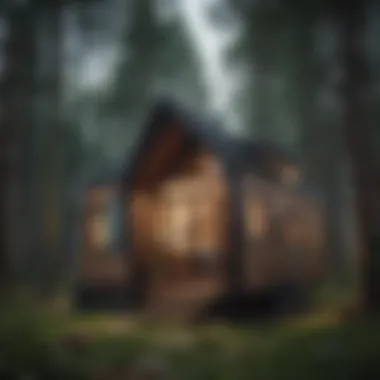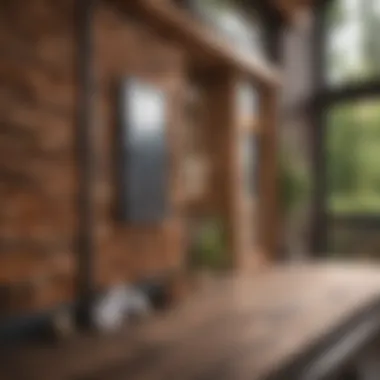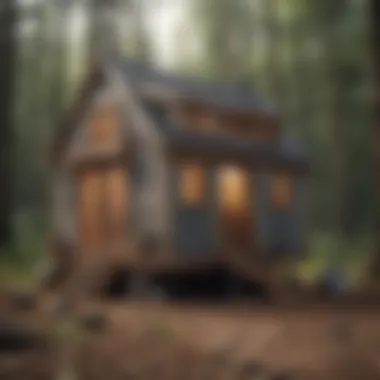Calculating the True Costs of Constructing a Tiny House: A Detailed Guide


Understanding Personal Finances
Budgeting Techniques
For those embarking on the journey of building a tiny house, mastering budgeting techniques becomes paramount. Keeping meticulous track of expenses ensures that every penny is accounted for, preventing unforeseen financial hurdles along the way. Utilizing spreadsheets or specialized software can aid in tracking expenditures, allowing for a comprehensive overview of where the money is allocated.
Tracking Expenses
In the realm of tiny house construction, tracking expenses is not merely a task but a necessity. From the initial outlay for materials to the labor costs incurred during the build process, every detail must be meticulously documented. This practice instills financial discipline and provides a clear picture of the overall expenditure involved in the project.
Setting Financial Goals
Setting clear financial goals lays the foundation for a successful tiny house building endeavor. Establishing achievable milestones, whether in terms of savings targets or project completion timelines, helps individuals stay focused and motivated throughout the construction process. By aligning financial objectives with overarching project goals, aspiring tiny house owners can navigate the construction journey with clarity and purpose.
Expert Insights and Tips
Financial Advisor Recommendations
In the intricate landscape of tiny house construction, seeking guidance from financial advisors can offer invaluable perspectives. These professionals specialize in navigating complex financial scenarios, providing tailored advice to individuals embarking on unique projects such as building a tiny house. Their expertise can shed light on optimizing financial resources, mitigating risks, and making informed investment decisions tailored to the specific requirements of a tiny house project.
Market Trends Analysis
Staying abreast of market trends is pivotal for individuals considering the construction of a tiny house. Analyzing fluctuations in material costs, labor rates, and overall economic conditions can help project planners make informed financial decisions. By leveraging market insights, aspiring tiny house owners can strategize effectively, aligning their construction timelines with favorable market conditions to optimize cost-efficiency.
Tax Planning Strategies
Navigating tax obligations is a critical aspect of tiny house construction, necessitating sound tax planning strategies. From understanding deductible expenses to leveraging tax incentives specific to housing projects, individuals venturing into tiny house building must prioritize tax efficiency. Engaging in proactive tax planning ensures compliance with regulations while maximizing financial benefits, ultimately contributing to the overall cost-effectiveness of the project.
Investment Strategies
Introduction to Investing
Exploring investment opportunities can be instrumental for individuals seeking to finance their tiny house ventures. By familiarizing themselves with basic investment principles, aspiring tiny house owners can identify avenues for generating additional funds to support their construction project. From stocks and mutual funds to alternative investment vehicles, understanding the fundamentals of investing can broaden financial horizons and empower individuals to make sound financial decisions.
Risk Management
Mitigating financial risks is paramount when embarking on a significant project like building a tiny house. Implementing risk management strategies, such as diversifying financial resources and contingency planning, safeguards individuals against unforeseen challenges that may impact project costs. By assessing and addressing potential risks proactively, aspiring tiny house owners can enhance financial resilience and ensure the successful realization of their construction goals.
Diversification


Diversification of financial resources is a cornerstone of prudent wealth management, especially in the context of financing a tiny house build. By spreading investments across different assets or income streams, individuals can reduce concentration risk and enhance portfolio stability. Diversification entails strategic allocation of resources to minimize potential losses and optimize returns, underscoring the importance of a comprehensive financial approach in the realm of tiny house construction.
Financial Products Overview
Types of Investment Vehicles
Understanding the diverse landscape of investment vehicles is essential for individuals considering funding options for a tiny house project. From traditional stocks and bonds to more innovative avenues like peer-to-peer lending and real estate crowdfunding, exploring various investment vehicles can illuminate possibilities for accumulating the necessary capital. By assessing the risk-return profiles of different investment instruments, aspiring tiny house owners can craft a customized financial strategy aligned with their preferences and financial objectives.
Savings Accounts
Building a financial cushion through savings accounts forms the bedrock of financial preparedness for tiny house construction. Establishing dedicated savings accounts for the project enables individuals to set aside funds systematically, preparing for both anticipated and unexpected expenses. By leveraging high-yield savings instruments or exploring specialized savings options, aspiring tiny house owners can optimize their financial reserves, bolstering financial security throughout the construction journey.
Credit Cards and Loans
Navigating the realm of credit cards and loans requires careful consideration for individuals embarking on tiny house construction. Choosing the right credit card options or loan products can provide additional financial flexibility, assisting in managing cash flow variations during the construction process. By assessing interest rates, terms, and repayment schedules, aspiring tiny house owners can make informed decisions regarding credit utilization, ensuring responsible financial management and sustainable project funding.
Retirement Planning
Retirement Savings Plans
While the focus may be on immediate financial needs associated with tiny house construction, considering long-term retirement plans is crucial. Exploring retirement savings plans, such as individual retirement accounts (IRAs) or employer-sponsored 401(k) plans, empowers individuals to secure their financial future beyond the project timeline. By balancing short-term investment goals with long-term retirement objectives, aspiring tiny house owners can cultivate a holistic approach to financial planning, ensuring financial well-being throughout various life stages.
Social Security Benefits
Encompassing social security benefits in the broader financial strategy for tiny house construction adds a layer of financial security. Understanding the nuances of social security programs and eligibility criteria can provide insights into supplementary income streams that support ongoing project funding. By maximizing social security benefits in conjunction with other financial resources, individuals can fortify their financial positions and enhance overall project sustainability.
Healthcare Costs
Anticipating healthcare costs is a vital component of comprehensive financial planning for tiny house construction. Evaluating healthcare needs, exploring insurance options, and factoring in potential medical expenses contribute to a realistic financial assessment of the project. By proactively addressing healthcare costs and allocating resources for contingencies, aspiring tiny house owners can mitigate financial risks and ensure stability in the face of health-related expenditures.
Prelims
Embarking on the journey of building a tiny house involves a meticulous understanding of the financial landscape underlying this endeavor. The realm of tiny houses, compact dwellings that offer a unique approach to living spaces, presents a fascinating mix of challenges and opportunities for enthusiasts seeking an alternative lifestyle. Exploring the costs associated with these small yet efficient structures unveils a world of detail, from the nuances of material selection to the intricacies of labor expenses.
Overview of Tiny Houses
Tiny houses epitomize a minimalist approach to living, where the focus lies on efficient use of space without compromising comfort. These diminutive abodes, often ranging from 100 to 400 square feet in size, are designed to optimize functionality and sustainability. With ingenious layouts, multifunctional furniture, and innovative storage solutions, tiny houses redefine modern living standards, catering to individuals embracing a simpler, eco-conscious lifestyle.
Rising Popularity of Tiny House Movement
The burgeoning popularity of the tiny house movement mirrors a societal shift towards sustainable living and financial independence. This architectural trend transcends mere housing preferences; it symbolizes a philosophy centered on reducing ecological footprints, cutting costs, and embracing a clutter-free existence. The allure of tiny houses extends beyond mere shelter; it embodies a mindset steering away from excess towards mindful consumption, resonating profoundly with individuals seeking a harmonious balance between living space and freedom.


Purpose of the Article
Delving deep into the financial intricacies of building a tiny house, this article aims to demystify the cost factors associated with this unique housing option. By elucidating the various expenses, regulations, and financing options entwined with tiny house construction, this piece serves as a comprehensive guide for individuals contemplating or already embarking on a tiny house project. Offering practical insights and strategic considerations, the article paves the way for informed decision-making and prudent financial planning in the realm of tiny house construction.
Factors Influencing Cost
In the realm of tiny house construction, understanding the intricate factors that influence costs is paramount. Every decision, from the location of construction to the choice of materials, plays a crucial role in determining the overall expenses incurred during the building process. By delving into these factors, individuals embarking on a tiny house project can make informed choices that align with their budgetary constraints and vision for their dream home.
Location of Construction
The location of construction stands out as a pivotal determinant influencing the overall cost of a tiny house project. Factors such as land prices, accessibility to utilities, and building regulations vary significantly depending on the region where the construction takes place. Urban areas generally entail higher land costs and stricter building codes, driving expenses up. In contrast, rural settings might offer more affordable land options but potentially come with challenges related to infrastructure and permits. Considering the location carefully and weighing the cost implications can make a substantial difference in the final budget allocation for the tiny house.
Size and Design Complexity
The size and design complexity of a tiny house profoundly impact the total cost of construction. While the allure of a small, minimalist living space is appealing, intricacies in design elements and customized features can escalate expenses. Factors such as the number of rooms, architectural intricacies, and functional amenities all contribute to the final price tag. Simplifying the design and opting for practicality over extravagance can help mitigate costs without compromising on the essence of a cozy tiny home.
Choice of Materials
Selecting the right materials for a tiny house project is a critical decision that directly correlates with the overall expenses. From sustainable options like reclaimed wood to high-end materials like stainless steel appliances, each choice carries its own price point. Balancing durability, aesthetics, and cost-effectiveness is key when outlining the material budget. Additionally, considering eco-friendly alternatives may align with sustainability values while also affecting the long-term maintenance costs of the tiny house.
Labor Costs
Labor costs constitute a significant portion of the total expenditure in building a tiny house. The expertise and specialization required in tiny house construction, including carpentry, plumbing, and electrical work, contribute to the overall labor expenses. Hiring skilled professionals versus opting for a DIY approach can have varying cost implications. It is essential to assess the trade-offs between cost and quality of workmanship when budgeting for labor expenses in a tiny house project.
Breakdown of Costs
Building a tiny house involves meticulous planning and budgeting to understand the financial commitments. The breakdown of costs in this article serves as a crucial aspect, shedding light on the different elements that contribute to the total expenses. From materials to labor to permits, each cost component plays a significant role in the overall expenditure. Understanding the breakdown of costs is essential for anyone considering embarking on a tiny house construction project.
Material Expenses
Lumber and Structural Materials
Lumber and structural materials are the backbone of any tiny house construction, providing the essential support and framework for the entire project. While lumber is a traditional choice, newer materials like engineered wood offer enhanced durability and sustainability. The key characteristic of lumber lies in its versatility and availability, making it a popular choice for builders. However, it's crucial to consider factors like cost-effectiveness and environmental impact when opting for lumber in the construction process.
Insulation
Insulation is a vital aspect of creating a comfortable and energy-efficient living space within a tiny house. Effective insulation helps regulate indoor temperature, reduce energy consumption, and enhance overall comfort. The key characteristic of insulation lies in its thermal resistance properties, preventing heat transfer and maintaining a stable interior climate. While insulation improves energy efficiency, it's essential to balance cost and performance when selecting insulation materials for a tiny house construction.
Roofing
The roofing material plays a significant role in protecting the tiny house from external elements and ensuring structural integrity. Whether opting for traditional shingles, metal roofing, or alternative materials, the key characteristic of roofing lies in its durability and weather resistance. The choice of roofing material should align with the climate of the building location, providing adequate protection against rain, snow, and sun exposure. Considerations such as longevity, maintenance requirements, and aesthetic appeal influence the decision-making process when selecting roofing materials for a tiny house.


Flooring
Flooring serves both functional and aesthetic purposes within a tiny house, providing a durable and visually appealing surface for daily activities. From hardwood to laminate to eco-friendly options, the key characteristic of flooring lies in its durability, ease of maintenance, and design versatility. Choosing the right flooring material is essential to create a comfortable and inviting living space while considering factors like cost, design preferences, and environmental impact.
Utilities Installation
Installing utilities such as electrical wiring, plumbing, and heating systems is essential for ensuring the functionality and livability of a tiny house. The key characteristic of utilities installation lies in its complexity and technical requirements, necessitating professional expertise for safe and efficient implementation. While utilities enhance convenience and comfort, it's important to allocate a budget for installation costs and prioritize energy-efficient solutions for long-term sustainability.
Regulatory Considerations
In navigating the realm of tiny house construction, regulatory considerations stand as a pivotal aspect requiring meticulous attention. These considerations encapsulate a plethora of factors that dictate the feasibility, legality, and safety of erecting a tiny house. To elucidate, zoning regulations, building codes compliance, land use restrictions, and utilities integration constitute the core pillars of regulatory considerations. Zoning regulations define where and how a tiny house can be situated, ensuring alignment with local laws and ordinances. Building codes compliance mandates adherence to construction standards to guarantee structural integrity and inhabitant well-being. Land use restrictions impose limitations on the purpose and location of tiny houses, safeguarding environmental harmony. Moreover, utilities and off-grid living entail the integration of essential services like water, sewage, and electricity, pivotal for a sustainable tiny house lifestyle.
Zoning Regulations
Zoning regulations, a linchpin of regulatory considerations, govern the designated land usage within specific zones or districts. These regulations layer the foundation for determining whether a tiny house can be legally established on a particular plot of land. Typically, zoning ordinances classify zones into residential, commercial, or industrial categories, each delineating permissible land usage practices. Understanding and abiding by zoning regulations is crucial for aspiring tiny house owners to preemptively address any land-use conflicts and ensure compliance with local jurisdiction requirements. By complying with zoning regulations, individuals can navigate the intricacies of land-use permissions and ascertain the viability of their tiny house construction endeavors.
Building Codes Compliance
Embodying a cornerstone of regulatory adherence, building codes compliance dictates the technical specifications and construction standards that must be met during the erection of a tiny house. These codes encompass a spectrum of safety, energy efficiency, and habitability mandates aimed at safeguarding occupants and prolonging the structure's longevity. By upholding building codes, individuals mitigate the risks associated with substandard construction practices, ensuring structural resilience against environmental stressors and natural disasters. Comprehending and integrating building codes compliance within the construction process is indispensable for fostering a secure and sustainable living environment within the confines of a tiny house.
Land Use Restrictions
Navigating the landscape of land use restrictions integral to the realm of tiny house construction unveils a matrix of limitations and guidelines delineating permissible land activities. These restrictions encapsulate directives on land allocation, parcel divisions, and land function specifications, influencing the permissibility of erecting a tiny house on designated land parcels. Compliance with land use restrictions is paramount for adhering to the prescribed land usage regulations, fostering environmental stewardship, and upholding community aesthetics. By acknowledging and respecting land use restrictions, individuals partake in responsible land stewardship and engender harmonious coexistence within the broader ecosystem.
Utilities and Off-Grid Living
Embracing the nuances of utilities and off-grid living epitomizes a fundamental aspect intertwining regulatory considerations with the operational functionality of a tiny house. Utilities encompass essential services like water supply, sewage management, and electrical power integration crucial for sustaining habitability within a tiny house. The convergence of utilities and off-grid living underscores the need to adopt sustainable practices that minimize reliance on external infrastructure while maximizing self-sufficiency. By mastering the art of utilities and off-grid living, individuals cultivate a self-reliant lifestyle, harnessing renewable resources to power their tiny house abode while fostering environmental consciousness and reducing ecological footprints.
Financing Options
In the realm of tiny house construction, understanding financing options is a crucial piece of the puzzle. While the allure of tiny living is undeniable, navigating the financial landscape is essential to turning this dream into a reality. The section delves into the various avenues individuals can explore to fund their tiny house projects efficiently. By shedding light on self-financing, tiny house loans, as well as grants and assistance programs, readers can gain a comprehensive view of how to approach the financial aspect of constructing a tiny home.
Self-Financing
Self-financing is a path that empowers individuals to take control of their tiny house project's financial trajectory. By utilizing personal savings, investment portfolios, or restructuring existing financial resources, aspiring tiny homeowners can avoid the complexities tied to traditional loans. Embracing self-financing allows for greater flexibility in decision-making, as there is no reliance on external lenders. However, individuals opting for self-financing should conduct meticulous assessments of their financial standing to ensure a smooth progression towards building their tiny abode.
Tiny House Loans
For those seeking external financial support, tiny house loans present a viable option. These specialized loans cater to the unique needs of tiny house enthusiasts, offering favorable terms and structures compared to conventional home loans. Prospective tiny homeowners can explore loan options from financial institutions or specialty lenders with expertise in tiny house financing. However, diligent research and comparison of loan offers are imperative to secure the most advantageous terms that align with individual financial situations.
Grants and Assistance Programs
Beyond conventional financing avenues, grants and assistance programs play a pivotal role in supporting affordable housing initiatives, including the construction of tiny houses. These programs, facilitated by governmental or non-profit organizations, aim to alleviate the financial burden associated with building a tiny home. Eligible applicants can access grants for materials, labor, or specific project components, enhancing the feasibility of their tiny house endeavors. Understanding the eligibility criteria and application processes for these programs is essential for leveraging this resourceful financial support.
Ending
In the realm of constructing a tiny house, the conclusion serves as a pivotal point, encapsulating the essence of meticulous planning and financial acumen required to undertake such a project successfully. Delving into the intricacies of tiny house construction inherently highlights the importance of meticulous budgeting, strategic decision-making, and adherence to regulatory frameworks. The conclusion section, although seemingly a conclusion, actually acts as a guidepost for individuals embarking on the journey of building a tiny house. It underlines the significance of understanding the multifaceted costs involved, ranging from material expenses to labor costs and permit fees. By emphasizing the nuances of financing options, zoning considerations, and customization choices, the conclusion crystallizes the complex financial landscape that aspiring tiny house owners must navigate. Additionally, the conclusion acts as a reflective lens, prompting readers to contemplate the broader implications of their tiny house project beyond the mere financial investment. As such, the conclusion effectively rounds off the article, offering readers a summarized insight into the intricate web of factors influencing the cost of constructing a tiny house, ultimately empowering them to make informed decisions and embark on their tiny house journey with confidence.







